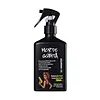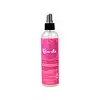What's inside
What's inside
 Key Ingredients
Key Ingredients

 Benefits
Benefits

 Concerns
Concerns

 Ingredients Side-by-side
Ingredients Side-by-side

Water
Skin ConditioningCetearyl Alcohol
EmollientPropanediol
SolventGlycerin
HumectantPolyquaternium-55
Dicocodimonium Chloride
EmulsifyingIsopropyl Alcohol
SolventCocos Nucifera Oil
MaskingSimmondsia Chinensis Seed Oil
EmollientIsoamyl Laurate
EmollientCitrus Aurantium Dulcis Oil
MaskingHydrolyzed Sweet Almond Protein
Skin ConditioningAloe Barbadensis Leaf Juice
Skin ConditioningSqualane
EmollientMagnesium Ascorbyl Phosphate
AntioxidantCurcuma Longa Root Extract
MaskingSodium Laneth-40 Maleate/Styrene Sulfonate Copolymer
Polyquaternium-11
Sodium PCA
HumectantDehydroacetic Acid
PreservativeBenzoic Acid
MaskingBenzyl Alcohol
PerfumingDisodium EDTA
Citric Acid
BufferingParfum
MaskingLinalool
PerfumingHexyl Cinnamal
PerfumingButylphenyl Methylpropional
PerfumingBenzyl Salicylate
PerfumingCoumarin
PerfumingCitronellol
PerfumingCitral
PerfumingBenzyl Benzoate
AntimicrobialAmyl Cinnamal
PerfumingIsoeugenol
PerfumingGeraniol
PerfumingAlpha-Isomethyl Ionone
PerfumingHydroxyisohexyl 3-Cyclohexene Carboxaldehyde
MaskingWater, Cetearyl Alcohol, Propanediol, Glycerin, Polyquaternium-55, Dicocodimonium Chloride, Isopropyl Alcohol, Cocos Nucifera Oil, Simmondsia Chinensis Seed Oil, Isoamyl Laurate, Citrus Aurantium Dulcis Oil, Hydrolyzed Sweet Almond Protein, Aloe Barbadensis Leaf Juice, Squalane, Magnesium Ascorbyl Phosphate, Curcuma Longa Root Extract, Sodium Laneth-40 Maleate/Styrene Sulfonate Copolymer, Polyquaternium-11, Sodium PCA, Dehydroacetic Acid, Benzoic Acid, Benzyl Alcohol, Disodium EDTA, Citric Acid, Parfum, Linalool, Hexyl Cinnamal, Butylphenyl Methylpropional, Benzyl Salicylate, Coumarin, Citronellol, Citral, Benzyl Benzoate, Amyl Cinnamal, Isoeugenol, Geraniol, Alpha-Isomethyl Ionone, Hydroxyisohexyl 3-Cyclohexene Carboxaldehyde
Water
Skin ConditioningGlycerin
HumectantPolysorbate 80
EmulsifyingSimmondsia Chinensis Seed Oil
EmollientAloe Barbadensis Leaf Juice
Skin ConditioningPunica Granatum Fruit Extract
AntioxidantCocos Nucifera Fruit Extract
EmollientButyrospermum Parkii Butter
Skin ConditioningCocos Nucifera Oil
MaskingTriticum Vulgare Germ Oil
EmollientCamellia Sinensis Leaf Extract
AntimicrobialAnthemis Nobilis Flower Extract
MaskingHydrolyzed Silk
HumectantLeuconostoc/Radish Root Ferment Filtrate
AntimicrobialDisodium EDTA
Potassium Sorbate
PreservativeGuar Hydroxypropyltrimonium Chloride
Skin ConditioningCitric Acid
BufferingMethylheptyl Isostearate
Skin Conditioning1,2-Hexanediol
Skin ConditioningCaprylhydroxamic Acid
Phenoxyethanol
PreservativePropanediol
SolventSodium Benzoate
MaskingBenzyl Benzoate
AntimicrobialHydroxycitronellal
PerfumingCitrus Limon Fruit Extract
MaskingLinalool
PerfumingParfum
MaskingWater, Glycerin, Polysorbate 80, Simmondsia Chinensis Seed Oil, Aloe Barbadensis Leaf Juice, Punica Granatum Fruit Extract, Cocos Nucifera Fruit Extract, Butyrospermum Parkii Butter, Cocos Nucifera Oil, Triticum Vulgare Germ Oil, Camellia Sinensis Leaf Extract, Anthemis Nobilis Flower Extract, Hydrolyzed Silk, Leuconostoc/Radish Root Ferment Filtrate, Disodium EDTA, Potassium Sorbate, Guar Hydroxypropyltrimonium Chloride, Citric Acid, Methylheptyl Isostearate, 1,2-Hexanediol, Caprylhydroxamic Acid, Phenoxyethanol, Propanediol, Sodium Benzoate, Benzyl Benzoate, Hydroxycitronellal, Citrus Limon Fruit Extract, Linalool, Parfum
Ingredients Explained
These ingredients are found in both products.
Ingredients higher up in an ingredient list are typically present in a larger amount.
Aloe Barbadensis Leaf Juice comes from leaves of the aloe plant. Aloe Barbadensis Leaf Juice is best known for helping to soothe sunburns. It is also anti-inflammatory, moisturizing, antiseptic, and can help heal wounds.
Aloe is packed with good stuff including Vitamins A, C, and E. These vitamins are antioxidants, which help fight free-radicals and the damage they may cause. Free-radicals are molecules that may damage your skin cells, such as pollution.
Aloe Barbadensis Leaf Juice also contains sugars. These sugars come in the form of monosaccharides and polysaccharides, folic acid, and choline. These sugars are able to help bind moisture to skin.
It also contains minerals such as calcium, 12 anthraquinones, fatty acids, amino acids, and Vitamin B12.
Learn more about Aloe Barbadensis Leaf JuiceBenzyl Benzoate is usually created from the condensation of benzoic acid and benzyl alcohol. It is used as a preservative, solvent, and has a floral/balsamic scent in large amounts.
As a preservative, Benzyl Benzoate works against bacteria and fungus. It is often used to treat scabies and lice in medicine.
Solvents are used to keep ingredients together in a product. They can help dissolve ingredients to stable bases or help evenly distribute ingredients throughout the product.
Due to its fragrance, Benzyl Benzoate can be sensitizing and may cause contact dermatitis. It is a known EU allergen. We recommend speaking with a professional if you have any concerns.
Benzyl Benzoate can be naturally found in cranberries and peaches.
Learn more about Benzyl BenzoateCitric Acid is an alpha hydroxy acid (AHA) naturally found in citrus fruits like oranges, lemons, and limes.
Like other AHAs, citric acid can exfoliate skin by breaking down the bonds that hold dead skin cells together. This helps reveal smoother and brighter skin underneath.
However, this exfoliating effect only happens at high concentrations (20%) which can be hard to find in cosmetic products.
Due to this, citric acid is usually included in small amounts as a pH adjuster. This helps keep products slightly more acidic and compatible with skin's natural pH.
In skincare formulas, citric acid can:
While it can provide some skin benefits, research shows lactic acid and glycolic acid are generally more effective and less irritating exfoliants.
Most citric acid used in skincare today is made by fermenting sugars (usually from molasses). This synthetic version is identical to the natural citrus form but easier to stabilize and use in formulations.
Read more about some other popular AHA's here:
Learn more about Citric AcidCocos Nucifera Oil is obtained from the kernels of the coconut fruit. In other words, this is coconut oil.
Coconut Oil is rich in fatty acids with lauric acid making up the majority of these. It also contains linoleic acid. Due to this high fatty acid content, coconut oil helps trap moisture and soften skin.
Despite being antibacterial, coconut oil may not be great for acne-prone skin. It is comedogenic and may clog pores. This ingredient may not be safe for malassezia or fungal acne.
Note: Coconut Oil should not replace your sunscreen for UV protection. Studies show it only blocks about 20% of UV.
This oil is non-volatile and has a light scent.
The term 'fragrance' is not regulated in many countries. In many cases, it is up to the brand to define this term. For instance, many brands choose to label themselves as "fragrance-free" because they are not using synthetic fragrances. However, their products may still contain ingredients such as essential oils that are considered a fragrance.
Learn more about Cocos Nucifera OilDisodium EDTA plays a role in making products more stable by aiding other preservatives.
It is a chelating agent, meaning it neutralizes metal ions that may be found in a product.
Disodium EDTA is a salt of edetic acid and is found to be safe in cosmetic ingredients.
Learn more about Disodium EDTAGlycerin is already naturally found in your skin. It helps moisturize and protect your skin.
A study from 2016 found glycerin to be more effective as a humectant than AHAs and hyaluronic acid.
As a humectant, it helps the skin stay hydrated by pulling moisture to your skin. The low molecular weight of glycerin allows it to pull moisture into the deeper layers of your skin.
Hydrated skin improves your skin barrier; Your skin barrier helps protect against irritants and bacteria.
Glycerin has also been found to have antimicrobial and antiviral properties. Due to these properties, glycerin is often used in wound and burn treatments.
In cosmetics, glycerin is usually derived from plants such as soybean or palm. However, it can also be sourced from animals, such as tallow or animal fat.
This ingredient is organic, colorless, odorless, and non-toxic.
Glycerin is the name for this ingredient in American English. British English uses Glycerol/Glycerine.
Learn more about GlycerinLinalool is a fragrance and helps add scent to products. It's derived from common plants such as cinnamon, mint, citrus, and lavender.
Like Limonene, this ingredient oxidizes when exposed to air. Oxidized linalool can cause allergies and skin sensitivity.
This ingredient has a scent that is floral, spicy tropical, and citrus-like.
Learn more about LinaloolParfum is a catch-all term for an ingredient or more that is used to give a scent to products.
Also called "fragrance", this ingredient can be a blend of hundreds of chemicals or plant oils. This means every product with "fragrance" or "parfum" in the ingredients list is a different mixture.
For instance, Habanolide is a proprietary trade name for a specific aroma chemical. When used as a fragrance ingredient in cosmetics, most aroma chemicals fall under the broad labeling category of “FRAGRANCE” or “PARFUM” according to EU and US regulations.
The term 'parfum' or 'fragrance' is not regulated in many countries. In many cases, it is up to the brand to define this term.
For instance, many brands choose to label themselves as "fragrance-free" because they are not using synthetic fragrances. However, their products may still contain ingredients such as essential oils that are considered a fragrance by INCI standards.
One example is Calendula flower extract. Calendula is an essential oil that still imparts a scent or 'fragrance'.
Depending on the blend, the ingredients in the mixture can cause allergies and sensitivities on the skin. Some ingredients that are known EU allergens include linalool and citronellol.
Parfum can also be used to mask or cover an unpleasant scent.
The bottom line is: not all fragrances/parfum/ingredients are created equally. If you are worried about fragrances, we recommend taking a closer look at an ingredient. And of course, we always recommend speaking with a professional.
Learn more about ParfumPropanediol is an all-star ingredient. It softens, hydrates, and smooths the skin.
It’s often used to:
Propanediol is not likely to cause sensitivity and considered safe to use. It is derived from corn or petroleum with a clear color and no scent.
Learn more about PropanediolThis oil comes from the seeds of the desert shrub called Jojoba. It is more commonly known as jojoba oil, a non-comedogenic oil.
Jojoba oil does not contain fragrance and has many fatty-acids, making it a great soothing ingredient.
It also contains Vitamin E, a great moisturizing ingredient. Vitamin E is also an antioxidant and protects your skin against oxidative damage.
This ingredient humectant properties, meaning it helps draw moisture from the air. This helps keep your skin hydrated.
While jojoba has antibacterial properties, it is only able to kill some strains of bacteria.
Studies also show it helps in wound healing. In fact, Indigenous cultures have used jojoba as a moisturizer and to help treat burns for centuries.
Fun fact: Jojoba oil similar to natural human skin sebum, so it has a great effect on dry skin. It is also promising with helping to regulate sebum production.
Due to its fatty acid content, Jojoba oil may not be fungal acne safe. We recommend speaking with a professional if you have any concerns.
Learn more about Simmondsia Chinensis Seed OilWater. It's the most common cosmetic ingredient of all. You'll usually see it at the top of ingredient lists, meaning that it makes up the largest part of the product.
So why is it so popular? Water most often acts as a solvent - this means that it helps dissolve other ingredients into the formulation.
You'll also recognize water as that liquid we all need to stay alive. If you see this, drink a glass of water. Stay hydrated!
Learn more about Water